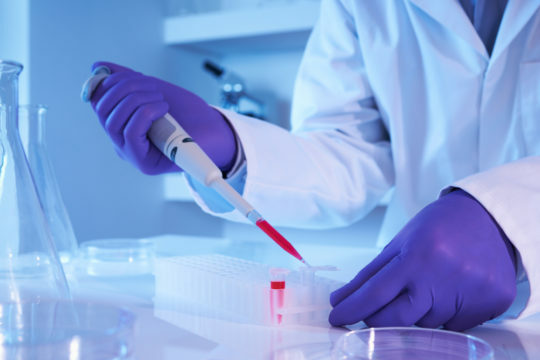Sensation of a lump in the throat is a condition that any person experiences from time to time. If such moments of discomfort in the throat become frequent, you should find out - what problems in the body cause such inconvenience?
Coma in the throat - causes of
In most cases, the com in the throat arises from the strain or spasmodic contraction of the neck muscles caused by the excitement or nervous shock of the .The lump in the throat can "stand" because of mechanical damage to the walls of the larynx, including due to a grossly performed gastroscopy - a visual internal examination of the esophagus, stomach and duodenum with the help of a gastroscopy.
If such a problem is constantly pursued without the presence of obvious irritants, then it can be a symptom of the following diseases:
- In the field of psychiatry - neurosis, somatized depression, "psychological carapace."
- In the field of vertebrology - spondylosis( displacement of the vertebrae) of the cervical spine.
- In the area of ENT - a number of diseases of the pharynx, which cause an increase in the size of the cervical and / or occipital lymph nodes, as well as tumors in the oropharynx, larynx, and trachea.
- In the field of gastroenterology - tumors of the esophagus, which make it difficult to swallow.
- In the field of endocrinology - hormonal imbalance, leading to an increase in size, the appearance of nodes and the development of tumors of the thyroid gland;acute inflammation of the parenchyma( thyroiditis);diffuse toxic goiter due to chronic shortage of iodine;hyperthyroidism.
Characterization analysis and functional groups

In order to correctly identify the disease that causes a coma problem in the throat and begin treatment, it is necessary to consult a therapist and go through the narrowly-consulted and necessary examinations of the relevant specialists. First of all, a preliminary analysis of symptoms and independent examination of the thyroid gland is recommended.
Functional com
Practitioners note that in 9 cases out of 10, there is a so-called functional comet when the problem is caused by neurotic states. Unrestrained attacks that occur late in the evening( after work) or against a background of nervous tension, and which do not occur on weekends or on vacation - these are the main symptoms of a functional variety.
Organic com
The remaining 1 case, refers to the organic type and requires close attention. Organic coma is caused by mechanical action on the esophagus or trachea, and is accompanied by the following non-passing symptoms:
- Difficulty breathing. The increased size of the thyroid gland, arisen nodes and tumors cause labored breathing( especially during meals).Such a symptomatology is due to the location of the thyroid gland - the esophagus is deeper and can not usually be squeezed by the enlarged dimensions of the gland, so the closely located trachea suffers.
- Spasmodic stress. In the case of diseases of the thyroid gland, which proceed without changing its volumes, the inflammatory process makes the gland tissue very dense, which leads to a spasmodic tension of the surrounding muscles, which patients describe as a "lump in the throat".
- Problems with swallowing. Tumors of the esophagus cause sustained discomfort when swallowing solid foods and swallowing liquids. Very rarely, but problems with swallowing can be caused by a very large and, as a rule, asymmetric form of the growth of the thyroid gland. To clarify the diagnosis with a problem swallowing, fibrogastroduodenoscopy( FGD) is performed.
Hormonal failure
Women aged 50 years can be immediately enrolled for admission to the endocrinologist if the constant sensation of a coma in the throat is accompanied by a violation of breathing during meals, while the person himself does not interfere with swallowing.
This is because the female thyroid gland wears out faster than the male. Menstruation, pregnancy and childbirth, menopause. Such, transferred during life, "female stress" on the thyroid gland are confirmed by a sad statistics - pathology is fixed in the ratio of 7 to 3( women: men) .By other calculations, women before menopause are ill at 10, and women after 50 years, 17 times more often than men. In general, thyroid diseases are firmly rooted in the second place, competing only with the leader of the list - diabetes mellitus.
Inspection at the mirror

For a visual description of the thyroid gland condition, a system with 5 degrees is used:
- zero increase - the iron is not probed and not visible;
- the first and second degree - sometimes it is possible to probe and it is possible to see at swallowing;
- the third - the thyroid gland is confidently palpated and visible in a calm state;
- fourth and fifth degree - in addition to the increased size of the gland, there is a significant increase in the size of the lower part of the neck.
For competent examination and palpation, it is necessary to straighten, slightly to throw back the head and periodically swallow( fixing the resulting sensations).The work of fingers during palpation should be smooth, without too deep and sharp pressing.
The definition of 1-2 degree of magnification is the motive for visiting an endocrinologist. In this case, it should be remembered that women after 50 years of age, it is necessary to visit the endocrinologist every year, even if no deviations from the norm were detected by visual inspection at the mirror.
If you find small nodes( up to 1 cm), do not panic - they are not dangerous, do not require intensive treatment or surgery, and are found in every second woman after 50 years, and an endocrinologist visit and an annual ultrasound is necessary to monitor the dynamics of growththese seals.
First signs of
What symptoms should cause alertness in everyone, especially in women over the age of 50?We list the main signs that arise in diseases with a decreased production of thyroid hormones and accompanied by a symptom of a "lump in the throat":
- Fail-free fast weight gain and the inability to reduce it by restricting nutrition and increasing physical exertion.
- Explicit symptoms of iron deficiency anemia against a background of full nutrition and a normal lifestyle:
- frequent malaise;
- rapid fatigue, muscle weakness and cramps;
- chills;
- headaches and dizziness;
- pre-occlusive conditions;
- dryness and tingling of the tongue;
- loss of appetite, excessive craving for sour, sharp, salty. There are perversions of taste - you want chalk, ice and raw cereals.
- Women complain of burning and itching of the vulva, dry skin, catastrophic changes with hair and nails. Especially on these symptoms should pay attention to women after 50, because with the onset of menopause and regular menstrual blood loss ends.
- The manifestation of keratosis is a dense, red-colored layer of skin on the elbows and "goose" skin on hips, calves and forearms. Edema and puffiness - due to a violation of the water-salt balance, the entire body swells, but the face suffers especially.
- Chronic constipation.
- Irrelevant irritability, capriciousness and a sharp change of mood.
- Forgetfulness, poor memory of new information, unclear thinking.
- Sleep disorders - severe drowsiness or prolonged absence of sleep.
- Decreased libido and indifference to sex.
- High blood pressure.
Women under 50 years, in addition to the above, often complain about:
- painful and long critical days;
- changes in voice - low tones and hoarseness;
- hearing loss, which occurs due to swelling of the mucous auditory passages.
Young women under 30 years old, suffering from a lack of thyroid hormones, look as if descended from the paintings of Ingra and Fragonard beauties: apathetic-languid, with a plump figure and with a characteristic thickening in the lower part of the neck;nezagorelie, but with golden "hepatitis" skin .Girls with this appearance should immediately consult a specialist - delay in treatment threatens miscarriages in the early stages of pregnancy or complete infertility caused by the cessation of ovulation due to a lack of hormone production by the thyroid gland.
Aggravating factors

Physicians believe that the increase in the number of thyroid diseases is associated with an increase in the number of stressful situations in modern life, environmental intoxication, a deficiency of selenium and fluoride, a violation of iodine balance in nutrition.
To all people after 50 years, and women - in particular, it is strongly recommended to perform a blood test to determine the level of thyroid-stimulating thyroid hormone - TSH( TSH).Earlier, generally accepted norms within the limits of up to 5.0 were obsolete. Today the norm is the boundary between 0.3 - 3.0.
If the TSH test is normal, and the state of health continues to be poor and there are symptoms of hypothyroidism, it is necessary to pass an analysis to determine the level of hormones T3( thyroxine) and T4( triiodothyronine) and pass the Anti-TPO test.
Treatment of
Treatment of thyroid gland is necessary only under the supervision of a specialist. Each patient has a strictly individual approach, and prescribed treatment, with time, can change. However, the general scheme of treatment is the same for everyone - early cases are adjusted with a special diet and dietary supplements, and more neglected cases are treated with hormone-containing drugs.
After the start of treatment, the first test should be performed after 3 months. If the results of blood tests do not have positive dynamics, then the endocrinologist will adjust the forms and doses of drugs. After reaching the normal level of TSH in the blood, control is carried out every 6 months.
Dietary food
Treat the thyroid gland with the appointment of a diet. The main recommendation officially confirmed by WHO is to replace the usual iodized salt with a daily intake rate of 150 μg for adults.
Useful products recommended for reduced thyroid function:
- sea fish, seaweed and seafood;
- sour-milk drinks with bifido- and acidophilic bacteria;
- cottage cheese;
- dried fruits, nuts and seeds;
- berries - blueberries, black currants, black-berry rowan, kiwi;dark varieties of grapes, pomegranate, gooseberries and persimmons;
- vegetables - string beans, turnips, avocados, cabbages;raw carrots, pumpkin and beets;
- birch sap, salads from dandelion and nettles.
- not strong green tea and honey.
The use of coffee and strong alcoholic beverages should be restricted.
Medications
To facilitate the work of the thyroid gland and normalize the hormonal background apply:
- hormone-containing drugs from various manufacturers with the general name L-thyroxine or L-thyrox, Triiodothyronine and Thyreocombe;
- iodine-containing dietary supplements "Iodine-Active" and "Iodine Balance", tableted pharmacological agents "Iodomarin" and potassium iodide;
- cream and capsules "Endocrinol", as an auxiliary source of flavonoids from the extract of medicinal plants - tadpole white, medium stellate and common flaxseed.
Surgical intervention
If dietary nutrition and hormonal treatment does not help restore the hormonal background, and tumors continue to grow, surgery is used. Even in case of diagnosing the oncological nature of tumors, one should not panic! In the case of oncology of the thyroid gland, current statistics indicate a very high percentage of patients successfully defeating cancer.
Healing physical activity
Physiotherapy specialists recommend long walks at a leisurely pace, visit the swimming pool, take relaxing massage classes, special stretch exercises( pilates) or practice yoga, and practice meditation.



